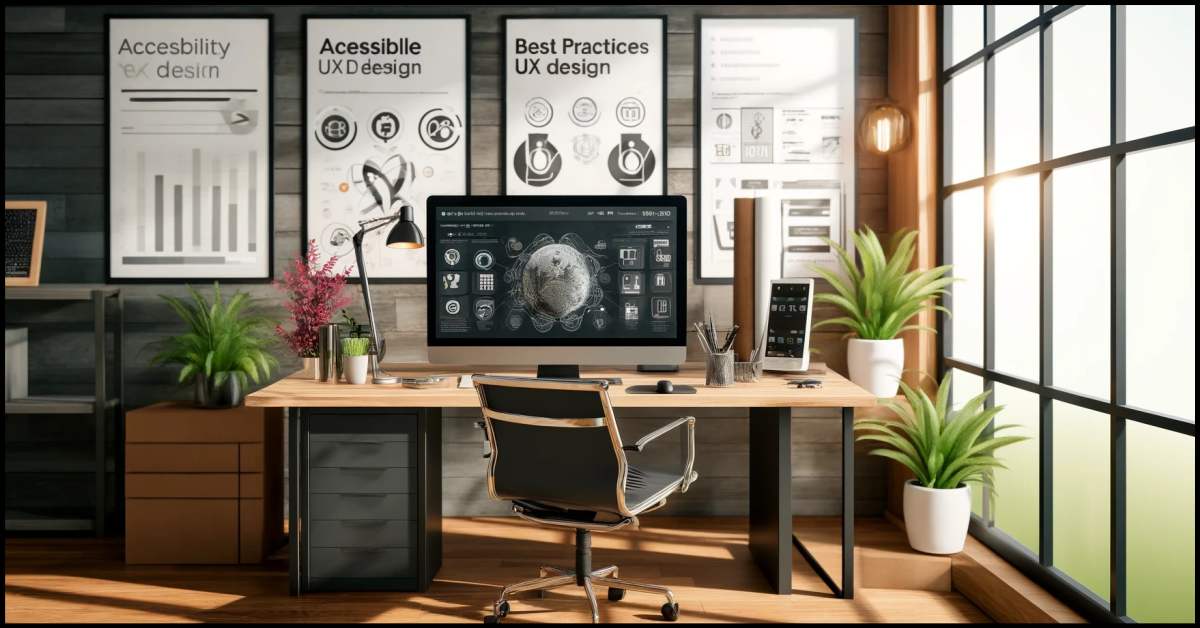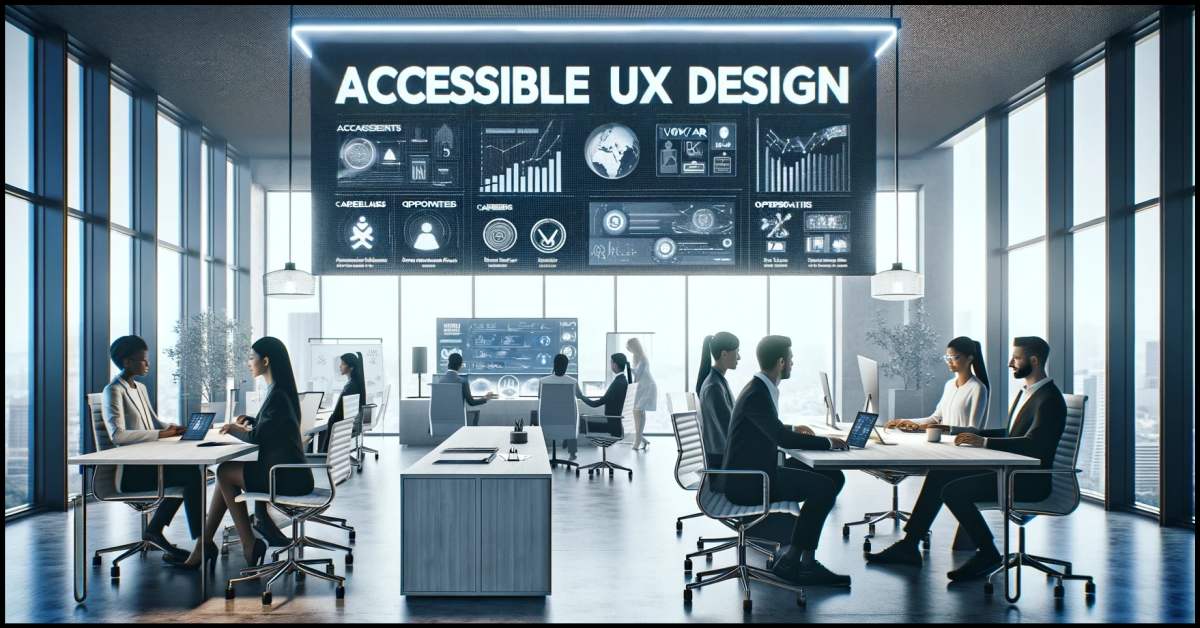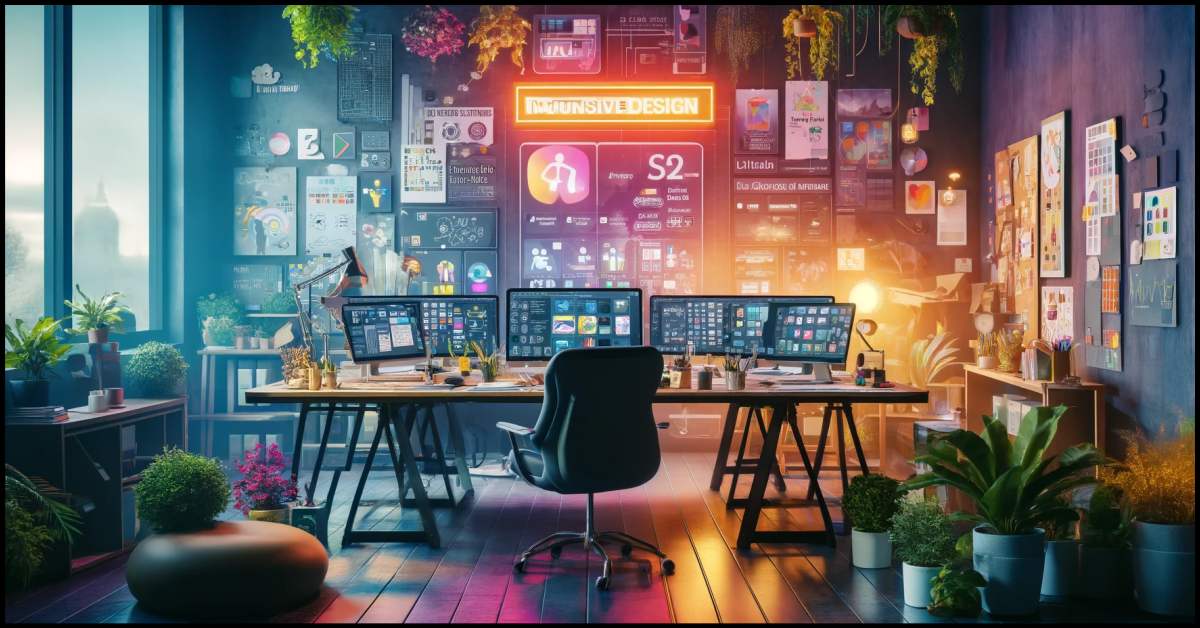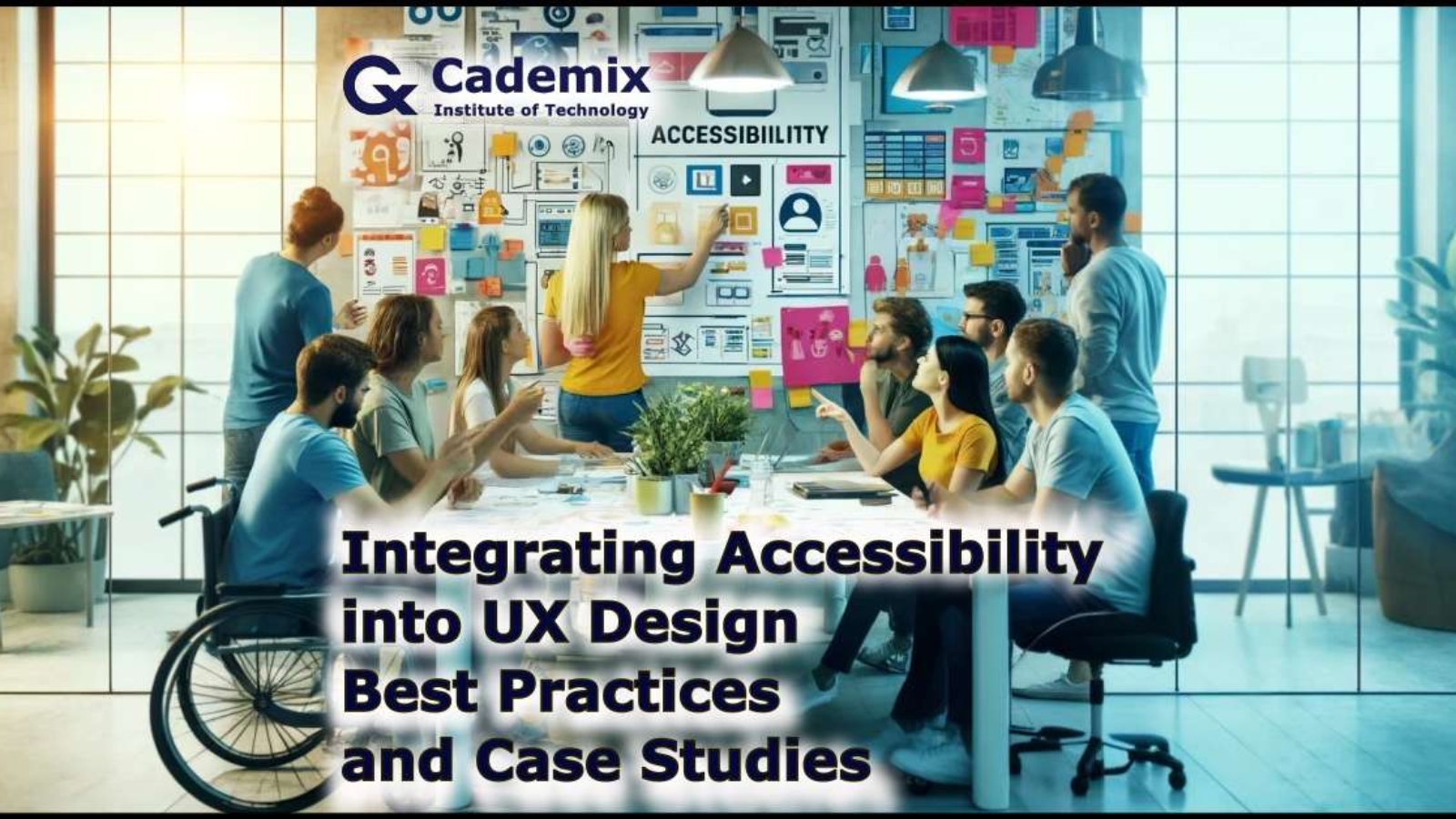This article explores the crucial role of accessibility within the realm of User Experience (UX) Design, emphasizing its impact on creating inclusive digital environments. As digital interfaces become more integral to everyday life, ensuring they are accessible to all users, including those with disabilities, is paramount. This exploration begins with an introduction to UX design frameworks and accessibility standards, highlighting the necessity of these elements in modern design practices. The paper then delves into best practices for integrating responsive design and user interface (UI) integration techniques that cater to a diverse user base.
By Samareh Ghaem Maghami, Associate Technical and Interior Designer at Cademix Institute of Technology
Introduction
In the rapidly evolving field of User Experience (UX) Design, the integration of accessibility standards is pivotal for creating inclusive and user-friendly digital products. As businesses aim to enhance user engagement across diverse demographics, the significance of employing UX design frameworks that incorporate robust accessibility features is paramount. This foundational approach ensures that all users, including those with disabilities, can interact seamlessly with digital interfaces, whether through mobile apps or expansive web platforms. This article will explore best practices and case studies, highlighting effective strategies for integrating accessibility in UX design, ensuring it remains at the forefront of digital innovation and inclusivity.

Understanding Accessibility in UX Design
Accessibility in User Experience (UX) design goes beyond mere compliance; it is a fundamental component that enhances user interaction and satisfaction across all digital platforms. UX design accessibility standards are critical in ensuring that digital products are usable by people with a wide range of abilities and disabilities. By adopting these standards, designers commit to a user-centered design process that considers the needs of individuals who experience disabilities—whether visual, auditory, motor, or cognitive.
Definition of UX Design
Accessibility in User Experience (UX) design goes beyond mere compliance; it is a fundamental component that enhances user interaction and satisfaction across all digital platforms. UX design accessibility standards are critical in ensuring that digital products are usable by people with a wide range of abilities and disabilities. By adopting these standards, designers commit to a user-centered design process that considers the needs of individuals who experience disabilities—whether visual, auditory, motor, or cognitive.
How accessibility enhances user-centered design processes
Implementing UX design accessibility standards is not only about adhering to legal requirements but also about embracing ethical practice and innovation within the design process. These standards serve as a benchmark for creating user interfaces (UI) that are navigable and understandable for all users, thus supporting responsive design for UX. They help in identifying and removing potential barriers that could prevent users from fully interacting with a digital product, ensuring that no user is left behind.
Moreover, by integrating accessibility guidelines into UX prototyping tools and frameworks, designers can utilize technology to simulate user interactions and get valuable insights into how accessible their designs are. Tools such as Figma for UX design have incorporated features that check for color contrast and readability, making it easier for designers to apply these standards throughout the design process.
The commitment to accessibility in UX design not only improves the user experience for individuals with disabilities but also enhances the overall usability for all users. It leads to more intuitive, more user-friendly interfaces that cater to a broader audience, ultimately resulting in more successful and universally appreciated digital products. This integration of accessibility stands at the core of a truly inclusive user-centered design process, underlining the necessity of UX design frameworks that prioritize accessibility from the outset.
US Design Best Practices
Creating accessible digital products requires a well-defined approach that integrates best practices throughout the design and development process. This section outlines the essential practices that enhance UX design through accessibility, ensuring that digital interfaces are usable and enjoyable for all users, including those with disabilities.
1. Prioritize Clear and Intuitive Navigation: Navigation should be straightforward to accommodate users with various disabilities. This includes creating consistent layouts, logical link placement, and interactive elements that are easy to identify. Tools like UX prototyping tools and wireframing in UX design play a crucial role in visualizing and testing navigation structures before they are fully implemented.
2. Utilize Responsive Design Techniques: Responsive design ensures that UX designs perform well on a variety of devices and screen sizes, which is crucial for users with visual impairments who may rely on different devices. Incorporating responsive design for UX from the initial stages ensures that accessibility is considered across all platforms.
3. Ensure Text Clarity and Readability: Text within the user interface should be easy to read for users with visual impairments. This involves using appropriate font sizes, high-contrast color schemes, and clear font styles. UX design frameworks that incorporate these elements help in reducing barriers for reading and understanding content.
4. Provide Alternative Text for Visual Content: Images, videos, and other visual content should include alternative text (alt text) descriptions. This practice not only supports users who use screen readers but also enhances SEO. Figma for UX design and other tools can assist in ensuring that all media have suitable alt text.
5. Implement Keyboard Navigation and Shortcuts: Many users with physical disabilities rely on keyboard navigation rather than a mouse. Designing with keyboard-only navigation in mind ensures that all functionalities are accessible via keyboard shortcuts, enhancing the user interface integration for accessibility.
6. Conduct Regular Usability Testing with Diverse Users: Usability testing techniques should include participants with a range of disabilities to get real-world insights into how accessible the design is. This feedback is invaluable and should be integrated into the UX design project management cycle to refine and optimize the user experience.
7. Train and Educate Design Teams: Ensuring that all members of UX design and cross-functional teams are knowledgeable about accessibility standards and best practices is critical. Regular training sessions and updates on the latest accessibility guidelines can drive innovation and awareness throughout the team.
By following these best practices, designers and developers can ensure that their digital products are not only compliant with UX design accessibility standards but also genuinely accessible and user-friendly. This proactive approach to accessibility in UX design fosters inclusivity, broadening the user base and enhancing the overall user experience. This commitment to inclusive design reflects the core values of user-centered design processes and sets the stage for more innovative and universally accessible digital products.

Tools and Technologies
In the domain of UX design, the right tools and technologies play a crucial role in crafting accessible digital products. This section delves into how designers can effectively use various UX prototyping tools, such as Figma, and other technologies to ensure their designs meet and exceed accessibility standards.
1. Figma for UX Design: Figma stands out as a powerful tool in UX design, particularly for its accessibility features. It allows designers to check color contrasts, simulate color blindness, and ensure that all elements are distinguishable for users with visual impairments. Figma’s collaborative nature also facilitates UX design collaboration, allowing teams to work together in real time to spot and fix accessibility issues early in the design process.
2. Accessibility Plugins and Extensions: Numerous plugins and extensions are available for UX prototyping tools that specifically focus on enhancing accessibility. These tools can automate part of the compliance process, such as ensuring adequate color contrast, evaluating text size, and providing code snippets that meet accessibility standards. Incorporating these tools into the UX design framework can save time and improve the accuracy of accessible designs.
3. Wireframing Tools for Conceptualizing Accessible Layouts: Wireframing is a crucial step in UX design, allowing for the rapid conceptualization and iteration of layouts. Using wireframing tools that support accessibility features helps designers plan layouts that are intuitive and navigable for all users, including those with disabilities. This early-stage integration of accessibility ensures that subsequent designs are built on a solid, inclusive foundation.
4. Automated Accessibility Testing Tools: Automated tools can scan and identify accessibility issues in a digital product before it goes live. These tools are integral to UX design project management, providing a quick and efficient method to catch and correct issues related to compliance with UX design accessibility standards throughout the development process.
5. Customizable UI Libraries with Accessibility in Mind: Many modern UI libraries and frameworks come with built-in accessibility features, such as ARIA (Accessible Rich Internet Applications) attributes and role definitions. These resources are invaluable for designers and developers looking to ensure that their applications meet legal and ethical standards for accessibility.
6. Training and Resources for Continuous Learning: Staying updated with the latest tools, trends, and techniques in accessible UX design is essential for professionals in the field. Engaging in continuous learning through webinars, workshops, and conferences focused on accessibility can enhance a designer’s skill set and keep them at the forefront of UX design innovations.
By integrating these tools and technologies into their workflow, UX professionals can significantly enhance the accessibility of their designs, ensuring a better user experience for everyone. This not only aligns with the principles of user-centered design but also fosters innovation and inclusivity in the digital landscape. This section underscores the importance of embracing technological advances and collaborative tools in the pursuit of creating universally accessible and user-friendly digital environments.

UX Research and User Testing
Conducting thorough UX research and applying rigorous usability testing are pivotal to integrating accessibility into the design process. This section outlines how employing specific UX research methods and usability testing techniques can ensure that digital products are truly accessible and meet the needs of all users, including those with disabilities.
1. Inclusive UX Research Methods: Effective UX research for accessibility involves gathering insights from a diverse user base, including people with various disabilities. Techniques such as interviews, surveys, and observational studies should be designed to extract detailed feedback on how accessible users find the interface. Using UX research methods that focus on inclusivity not only broadens the understanding of user needs but also enhances UX design project management by informing more empathetic and practical design decisions.
2. User Persona Development for Diverse Needs: Developing user personas that include individuals with disabilities is crucial. These personas should represent a range of physical, sensory, and cognitive abilities, ensuring that the design process addresses their specific needs and preferences. Integrating these personas into the UX design framework helps guide design decisions toward greater inclusivity.
3. Usability Testing with Accessibility in Focus: Usability testing techniques must specifically target accessibility features. This involves testing with participants who have disabilities to understand their interaction patterns and challenges. Tools like screen readers, alternative input devices, and accessibility testing software should be used to evaluate how well the digital product supports users with different abilities.
4. Iterative Design and Feedback Loops: Accessibility should be viewed as an ongoing commitment rather than a one-time check. Employing an agile UX design process that includes regular iterations and feedback can help continually improve the product. Each cycle of testing and feedback should be used to refine and enhance the accessibility features, ensuring that the product evolves with user needs and expectations.
5. Collaboration Across Cross-functional Teams: Effective accessibility integration requires collaboration between UX designers, developers, accessibility consultants, and other stakeholders. Cross-functional teams should work together seamlessly, using UX design collaboration tools to share insights, strategies, and innovations. This collective approach ensures that accessibility is woven into every aspect of the product development lifecycle.
6. Documenting and Sharing Findings for Broader Impact: Documenting the findings from usability tests and research studies not only supports the current project but also contributes to the broader field of accessible UX design. Sharing detailed case studies and best practices can help educate and inspire other professionals in the industry, promoting a culture of inclusivity.
By implementing these UX research and usability testing practices, designers and developers can ensure that their products are not only compliant with accessibility standards but are also genuinely accessible and satisfying for all users. This commitment to thorough research and testing demonstrates a deep dedication to user-centered design and sets a standard for excellence in the creation of inclusive digital experiences.
Collaborative UX Design
In the pursuit of creating accessible digital products, collaboration among diverse teams is paramount. This section explores how cross-functional team dynamics and effective UX design collaboration techniques can elevate the accessibility of digital interfaces, making them more user-friendly for individuals with disabilities.
1. Role of Cross-functional UX Teams: Integrating accessibility into UX design demands the expertise and viewpoints of diverse professionals, including UX/UI designers, developers, accessibility specialists, and content strategists. Cross-functional UX teams leverage this varied expertise to ensure that accessibility considerations are embedded throughout the design and development process. This collaborative approach enhances digital product UX strategies, leading to more thoughtful and inclusive products.
2. Fostering UX Design Collaboration: Effective communication and collaboration tools are essential for synchronizing the efforts of team members. Platforms that support real-time collaboration and feedback, such as Figma for UX design, enable team members to work together seamlessly, regardless of their physical locations. These tools also facilitate the integration of UX design project management practices that prioritize accessibility tasks and milestones.
3. Integrating User-Centered Design Processes: A user-centered design process is critical for accessibility, focusing on the needs, challenges, and preferences of users with disabilities. Engaging with users through interviews, user testing sessions, and feedback loops ensures that the design solutions are not only theoretical but grounded in real user experiences. This integration of user-centered design enhances UX research methods and helps in developing more accurate user personas that reflect the diversity of the user base.
4. Utilizing UX Prototyping Tools for Accessibility Testing: UX prototyping tools that incorporate accessibility features allow teams to quickly create and test interfaces for accessibility compliance and usability. Prototyping early and often, using tools equipped with accessibility checking functions, ensures that any potential issues are identified and addressed well before the final development stages.
5. Leveraging UX and Agile Methodologies: Adopting agile methodologies in UX design projects facilitates a more iterative and responsive approach to accessibility. Agile practices encourage regular reviews and adaptations based on ongoing testing and feedback, making it easier to integrate changes that enhance accessibility throughout the project lifecycle.
6. Case Studies and Shared Learning: Documenting and sharing successful case studies within and across teams can be highly beneficial. These case studies not only serve as a reference for addressing similar challenges in future projects but also help in disseminating knowledge and best practices in UX design accessibility standards across the industry.
By cultivating a culture of collaboration and continuous improvement, cross-functional teams can more effectively address the complexities of accessibility in UX design. This collective effort not only leads to the development of products that are accessible to a wider range of users but also fosters a broader understanding and implementation of inclusive design practices within the digital landscape. Through strategic collaboration and the effective use of UX design tools and methodologies, teams can create more engaging, accessible, and successful digital experiences.

Case Studies: Successful Accessibility Integrations
Case studies serve as invaluable resources for understanding how theoretical accessibility principles are applied in real-world scenarios. This section highlights several successful case studies where accessibility has been effectively integrated into UX design, providing actionable insights and inspiration for designers and developers.
1. Major E-Commerce Platform Redesign: A leading e-commerce company revamped its website and mobile app to enhance accessibility. By adopting a user-centered design process and implementing UX design frameworks focused on inclusivity, the company significantly improved navigation and readability for users with visual and motor impairments. Key changes included keyboard-friendly navigation, high-contrast color schemes, and alternative text for all images. This project not only boosted customer satisfaction across the board but also increased the site’s usability and sales from users who previously struggled with the platform’s accessibility.
2. Government Services Website Overhaul: A government agency redesigned its public service portal to meet and exceed UX design accessibility standards. By involving cross-functional UX teams in the design process and utilizing UX prototyping tools, the website was transformed to be fully compliant with the Web Content Accessibility Guidelines (WCAG). Features such as text-to-speech functionality, easy-to-understand language, and accessible forms were integrated, making government services more accessible to citizens with various disabilities.
3. Financial Services Mobile App Accessibility Enhancement: A financial institution focused on enhancing the accessibility of its mobile application to better serve customers with disabilities. Through rigorous usability testing techniques and ongoing feedback from users with disabilities, the app incorporated voice commands, screen reader support, and clear visual cues for critical actions like transactions and alerts. This commitment to accessibility helped improve the financial independence of its users with disabilities.
4. Healthcare Portal for Enhanced Patient Access: A healthcare provider implemented an accessible online portal that allows patients to easily navigate their health information, schedule appointments, and communicate with healthcare professionals. The portal was designed with input from users of varying abilities and included features like adjustable text sizes, high-contrast modes, and simple, intuitive navigation. This case study highlights how UX design innovations and responsive design for UX can significantly improve the user experience for patients, especially those with special needs.
5. Educational Tool Accessibility Initiative: An educational technology company redesigned its learning management system (LMS) to be more accessible. The redesign focused on user persona development that included learners with disabilities. Features such as captioned videos, keyboard navigability, and content that adhere to accessibility guidelines were incorporated. The project emphasized the importance of UX design project management in ensuring that all phases of the redesign addressed the diverse needs of all learners.
These case studies illustrate the transformative power of integrating accessibility into UX design. By embracing best practices, employing the right tools, and engaging in effective collaboration, organizations can create digital products that are not only inclusive but also commercially successful and widely acclaimed. Each case study provides a blueprint for how businesses can navigate their own accessibility challenges and underscores the critical importance of making digital accessibility a cornerstone of UX design

Mobile and Web Applications
Ensuring accessibility in both mobile and web applications is a crucial aspect of UX design that targets a truly inclusive user experience. This section discusses the unique challenges and strategic solutions involved in designing accessible mobile and web applications, emphasizing how these efforts can broaden user engagement and enhance usability for all.
1. Responsive Design for Mobile and Web: Responsive design is essential in making applications accessible on various devices with different screen sizes and resolutions. UX designers must ensure that their applications adapt seamlessly across devices, providing a consistent experience that accommodates users with various disabilities. Techniques like fluid grid layouts, flexible images, and media queries are integral to achieving responsive design in UX.
2. Touch Accessibility for Mobile Apps: Mobile applications pose specific challenges such as touch targets that are too small or too closely spaced for users with motor disabilities. To address this, designers should ensure that touch targets are appropriately sized and spaced. Additionally, providing gesture simplification and alternative navigation options can greatly enhance the accessibility of mobile interfaces.
3. Visual Design and Contrast: Visual impairments require particular attention to color contrast and font size. Designers should use high-contrast color schemes that comply with WCAG guidelines and allow users to customize text size and color settings. Tools like Figma for UX design help in checking and adjusting these elements quickly during the design process.
4. Audio and Visual Alternatives: Integrating alternative text for images, transcripts for videos, and audio descriptions can significantly improve accessibility for users with hearing or visual impairments. These features should be an integral part of the development process to ensure that all users can access content in a way that suits their needs best.
5. Cross-Functional Team Involvement: Developing accessible mobile and web applications requires the collaboration of cross-functional teams that include UX designers, developers, accessibility consultants, and the users themselves. This collaboration should focus on regular testing and feedback cycles, using both automated tools and real user testing to iterate on design solutions that address accessibility challenges effectively.
6. Advanced Technologies and Innovations: Embracing new technologies such as AI and machine learning can offer innovative solutions to accessibility challenges in mobile and web applications. For example, AI can be used to dynamically adjust user interfaces based on the user’s behavior and preferences or to provide real-time audio descriptions for video content.
By focusing on these strategies, UX designers and developers can overcome the inherent challenges associated with designing for diversity in mobile and web applications. These efforts not only ensure compliance with accessibility standards but also enhance the overall user experience, leading to products that are universally accessible and appreciated. This comprehensive approach to accessibility underlines the importance of inclusive design in building digital products that cater to the needs of all users, regardless of their abilities.
Future Trends and Career Opportunities
As digital landscapes evolve, so do the trends in UX design, particularly in the realm of accessibility. This section explores emerging trends that are shaping the future of accessible UX design and highlights the career opportunities these trends are creating for professionals in the field.
1. Increasing Importance of AI in Accessibility: Artificial intelligence is becoming a pivotal tool in enhancing UX design accessibility. AI can automate complex processes such as accessibility testing, optimize layouts based on user behavior, and provide predictive text and voice recognition capabilities that improve accessibility for users with various disabilities. Embracing AI technologies in UX projects can lead to more adaptive and intuitive user experiences.
2. Virtual Reality (VR) and Augmented Reality (AR) for Immersive Accessible Experiences: VR and AR are breaking new ground in creating immersive user experiences that are also accessible. These technologies can simulate real-world experiences for users with disabilities, offering new ways to interact with digital content that bypass traditional accessibility barriers. UX designers are challenged to innovate within these mediums to ensure they are inclusive and accessible.
3. Universal Design Principles Becoming Standard Practice: The concept of universal design, which advocates for creating products usable by all people without the need for adaptation, is increasingly being integrated into UX design frameworks. This shift emphasizes the need for accessibility to be considered from the outset of the design process, not as an afterthought.
4. Growth in Remote Collaboration Tools: The rise of remote work has led to an increased demand for tools that support collaboration among dispersed teams, including those working on accessibility issues. These tools are crucial for facilitating UX design collaboration and ensuring that accessibility considerations are effectively communicated and implemented across teams.
5. Expansion of Regulatory Requirements for Accessibility: As legal requirements for digital accessibility continue to expand globally, there is a growing need for UX professionals who are well-versed in compliance standards. This trend is opening up new career paths focused on accessibility consulting and legal compliance in digital design.

Career Opportunities in Accessible UX Design
With these trends, there are numerous career opportunities emerging for UX professionals who specialize in accessibility:
1. Accessibility Specialist: Professionals who specialize in accessibility can work as consultants or in-house experts, guiding teams on best practices, compliance standards, and innovative accessibility solutions.
2. Agile UX Designer with a Focus on Accessibility: UX designers with expertise in agile methodologies and a strong understanding of accessibility can lead projects that require rapid iteration and responsiveness to user needs.
3. UX Researcher Focused on Inclusive Practices: There is a significant demand for UX researchers who can conduct studies focusing on the usability of products by people with disabilities, ensuring that their needs are considered during product development.
4. Regulatory Compliance Officer in UX: Professionals with a deep understanding of legal standards around accessibility can ensure that digital products meet regulatory requirements, reducing the risk of legal challenges.
5. Educator and Trainer in UX Accessibility: There is a growing need for educators who can teach accessibility principles to upcoming designers and developers, ensuring the next generation of professionals builds accessible and inclusive digital products from the ground up.
By staying ahead of these trends and understanding the associated career opportunities, UX professionals can position themselves at the forefront of the field, championing accessibility and shaping the future of inclusive digital experiences. This proactive approach not only enhances their career prospects but also contributes significantly to the broader goal of universal accessibility in digital design.
Conclusion
The integration of accessibility into UX design is not merely a requirement but a fundamental aspect of creating inclusive and universally enjoyable digital products. Throughout this article, we have explored how accessibility can be seamlessly incorporated into various stages of the UX design process, from the initial frameworks and tools to the collaboration techniques and emerging trends that shape the industry’s future.
Accessibility in UX design enhances the user experience for everyone, not just those with disabilities. It leads to the creation of products that are more intuitive, more widely usable, and ultimately more successful in the marketplace. By adhering to and exceeding accessibility standards, designers and developers ensure that their digital products are not only compliant but also set a benchmark in user-centric innovation.
The case studies highlighted throughout this article demonstrate the practical applications of these principles, showing that thoughtful, accessible design leads to positive user experiences and better business outcomes. Furthermore, as the digital landscape evolves, the importance of maintaining and advancing accessibility standards cannot be overstated. UX professionals who embrace these challenges and opportunities can lead the way in creating more accessible, inclusive, and successful digital environments.
As we look to the future, it is clear that the field of UX design will continue to evolve, bringing new challenges and opportunities for integrating accessibility. It is crucial for professionals in the field to engage in continuous learning, stay updated with the latest trends, and apply innovative solutions to enhance accessibility. The development of digital products must consider the diverse needs of all users from the outset, and designers must continually seek to improve their understanding and implementation of accessibility principles.
This commitment to inclusive design is not only a professional duty but also a social responsibility. By fostering environments that prioritize accessibility, UX professionals contribute to a more equitable digital world. Let us challenge ourselves to think beyond mere compliance and toward a future where digital accessibility is woven into the fabric of all UX design projects, creating a digital landscape that truly accommodates everyone.

About the Author
Samareh Ghaem Maghami, an eco-design master’s student at FH Wiener Neustadt and former interior decorator, combines a deep appreciation for aesthetics with a practical approach to user accessibility. Originally from Iran and now based in Austria, Samrah applies her diverse background in painting and event management to the realm of UX design. Her focus is on creating digital products that not only respect environmental sustainability but also ensure inclusivity, aligning her work with both ecological values and the diverse needs of users.
She is also an Associate Technical and Interior Designer at Cademix Institute of Technology and a member of the Cademix Career Autopilot Program.
Please feel free to contact her under:
E-mail: sam.gh.maghami@gmail.com
E-mail: samareh.ghaem-maghami@cademix.org
LinkedIn: https://www.linkedin.com/in/samareh-ghaem-maghami
Xing: https://www.xing.com/profile/Samareh_GhaemMaghami

